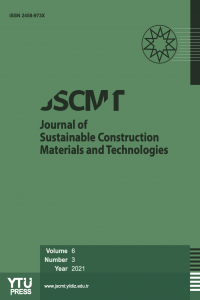An architectural query of Anthropocene Era: Planned obsolescence
An architectural query of Anthropocene Era: Planned obsolescence
Modernity, planned obsolescence secularization, Anthropocene,
___
- Lefebvre, H. (2020). The production of space. (I. Ergüder, trans.). Sel Publishing.
- Zalasiewicz, J., Williams, M., Barry, T.L., & Cantrill, D.J. (2008). Are we now living in the Anthropocene? GSA Today, 18 (2), 4-8. [CrossRef]
- Rickards, L. A. (2015). Metaphor and the anthropocene: Presenting humans as a geological force. Geographical Research, 53(3), 280-287. [CrossRef]
- Rockström, J. (2009). A safe operating space for humanity. Nature, 461, 472-475.
- Castree, N. (2014). The Anthropocene and geography I: The back story. Geography Compass, 8 (7), 436-449. [CrossRef]
- Çaylı, E. (2020). The aesthetics of climate: Essays on anthropocene art and architecture. Everest Publications. [CrossRef]
- Portzamparc, C. D., & Sollers, P. (2010). Writing and seeing architecture (C. İleri, trans.). Yapı Kredi Publishing.
- Güçlü, İ. (2021). Research methods in social sciences: Technique-approach-application. Nika Publishing House.
- Abandonedspaces (2023). https://www.abandonedspaces.com/
- Harvey, D. (2012). Paris, Capital of Modernity (B. Kılınçer, trans.). Sel Publishing.
- Heidegger, M. (2001). Nietzsche's word "God is dead" (L. Özşar, trans.). Asa Kitabevi.
- Touraine, A. (2002). Critique of Modernity. (H. Tufan, trans.). Yapı Kredi Publishing.
- Sertsarı Aslan, E., & Birer, E. (2021). Reading the post-pandemic period public space design through the Aldo Rossi aphorism. İdealkent, 12(34), 1614-1644. [CrossRef]
- Heidegger, M. (1977). The question concerning technology and other essay. (W. Lovitt, trans.). Garland Publishing.
- Begeç, S. (2019). An object as a plastic element in the context of Modernity. International Journal of Innovative Approaches in Social Sciences, 3(4), 106-127. [CrossRef]
- Güler, İ. (2001). The 'deep perversion' that has happened to the world: Worldliness. Journal of Islam, (3), 35-58.
- Bird Rose, D., Dooren, T., Chrulew, M., Cooke, S., Kearnes, M., & O'Gorman, E. (2012). Thinking through the environment, unsettling the humanities. Environmental Humanities, 1(1), 1-5. [CrossRef]
- Jeffries, B. (2020). The loss of nature and the rise of pandemics. WWF International.
- Slade, G. (2006). Made to break: Technology and obsolescence in America. Harvard University Press. [CrossRef]
- London, B. (1932). Ending the depression through planned obsolescence. Unknown. https://upload.wikimedia.org/wikipedia/commons/2/27/London_%281932%29_Ending_the_depression_through_planned_obsolescence.pdf
- Kırbaş Akyürek, B. (2019). Planned obsolete architecture architecture: Build –destroy-throw away. A. Ciravoğlu (Ed.). Ters Köşe Ekoloji. Puna Publishing.
- Packard, V. (1961). The waste makers. Lowe & Brydone.
- BoredPanda (2023). 119 Heartbreaking photos of pollution that will inspire you to recycle. https://www.boredpanda.com/environmental-pollution/?utm_source=google&utm_medium=organic&utm_campaign=organic
- Colford, K. (2021). Decay crisis: Organizing information in the built environment. Congress presentation. Istanbul Design Biennial, Istanbul Kültür Sanat Vakfı. https://tasarimbienali.iksv.org/i/assets/tasarim-bienali/documents/Katie_TR.pdf .
- Yıldırım, A. (2018). On the concept of secularisation. Avrasya Terim Magazine, 6(2), 46-54.
- Cox, H. (1965). The secular city. The Macmillan Company.
- Ekinci, İ. (2018). Secularization and religion. Journal of Bitlis Eren University Institute of Social Sciences, 7(1), 320-337.
- Gettyimages (2023). https://www.gettyimages.com/
- Urry, J. (2018). Consuming place. (R.G. Öğdül, trans.). Ayrıntı Publishing.
- Coşkun, C. (2007). Consumer society and the internet. [Unpublished master's dissertation]. Inönü University.
- Jacobs, J. (2017). The death and life of great American cities. (B. Doğan, trans.). Metis Publishing.
- Tschumi, B. (2018). Architecture and disjunction. (A. Tümertekin, trans.). Janus Publishing.
- Best Attractions (2023). The rise and fall of Hawthorne Plaza Mall in Hawthorne, CA – A nostalgic journey through time. https://bestattractions.org/usa/california/hawthorne-plaza-in-hawthorne-ca/
- Daily Breeze (2023). http://blogs.dailybreeze.com/history/2010/10/20/hawthorne-plaza/
- Fotospot (2023). Abandoned hawthorne plaza mall. https://fotospot.com/attractions/california/abandoned-hawthorne-plaza-mall
- Chairman (2009). Banker Kastelli. https://irmakcan.wordpress.com/2009/08/01/banker-kastelli-3/
- Işık, A. (2018). Banker Kastelli. https://abdullahabdurrahman.wordpress.com/2018/12/16/banker-kastelli-alintidir/
- Urbex.nl (2023). Doel: The abandoned village in Belgium. https://www.urbex.nl/doel/
- Sözcü (2022,). An abandoned Chinese village that nature has taken over. https://www.sozcu.com.tr/hayatim/seyahat/doganin-ele-gecirdigi-koy/
- Lefebvre, H. (2017). The right to the city. (I. Ergüden, trans.). Sel Publishing.
- Başlangıç: 2016
- Yayıncı: Yıldız Teknik Üniversitesi
Oluwafemi AKANDE, Chioma EMECHEBE, Jonam LEMBİ, Joy NWOKORİE
An architectural query of Anthropocene Era: Planned obsolescence
Performance of Superabsorbent Polymer as Admixture in Hollow Concrete Blocks
Phoebe Love CANDANO, Kate Rose ELORDE, Irl Rica Ann MEJOS, Rhoe James CABADA, Val Irvin MABAYO
Assessment of a new rigid wall permeameter for the slurry like barrier materials: zeolite example
Şevket Onur KALKAN, Lütfullah GÜNDÜZ
Hussaini MATO, Yahaya Hassan LABARAN, Dipanjan MUKHERJEE, Gaurav SAİNİ, Mahmoud Murtala FAROUQ
Mechanical behavior of large-diameter pipe elbows under low-cyclic loading
